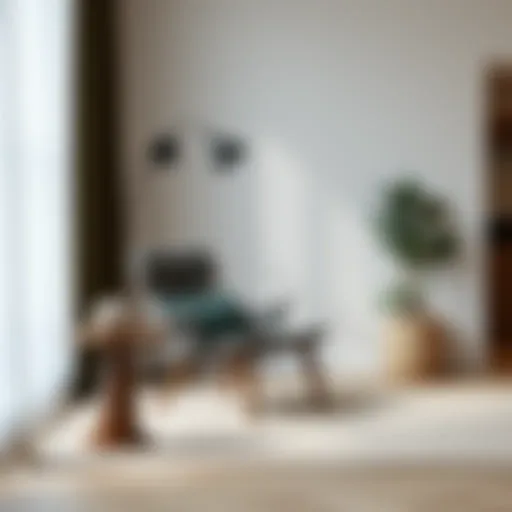Exploring the Versatility of Sonos Shelves: A Detailed Guide
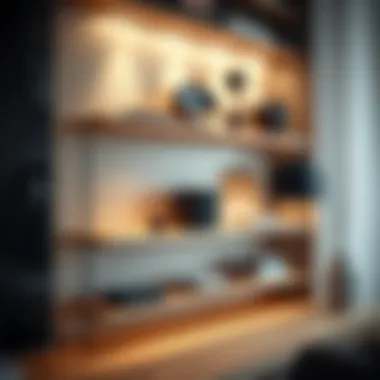

Intro
When it comes to crafting a home that reflects personal style while ensuring functionality, the role of innovative furniture cannot be overstated. One product that stands at the intersection of design and practicality is the Sonos shelf. These unique shelves not only serve as a stylish addition to any room but also enhance the auditory experience by integrating seamless sound systems into our living spaces.
In this guide, we’ll unravel the many layers of Sonos shelves—from their cutting-edge design to how they harmoniously blend into modern decor schemes. With a focus on their versatility, we will explore material types, arrangement ideas, and practical applications that can transform your ambiance.
By the end of this exploration, you’ll have a comprehensive understanding of how best to leverage the benefits of Sonos shelves in enhancing your home.
Furniture Design Trends
In today's fast-paced design world, the focus leans heavily toward multifunction and aesthetic cohesion. Sonos shelves embody this trend perfectly, allowing for a seamless integration of entertainment and décor.
Trending Materials and Textures
The materials used for shelving have shifted dramatically over the years, embracing both natural and synthetic components. Common options include:
- Wood: Oak, walnut, and pine continue to be classic choices for warmth and durability.
- Metal: Sleek steel or aluminum gives a modern edge and can support heavier audio equipment.
- Glass: Often used in conjunction with other materials, glass can add transparency and elegance to create the feeling of more space.
- Composite Materials: Engineered woods or plastics offer sustainable options without sacrificing aesthetics.
It’s vital to consider how these materials can either match or contrast with existing décor, fostering an inviting atmosphere.
Color Palettes and Styles
Choosing the right colors plays a crucial role in ensuring that Sonos shelves enhance a room's overall appeal. Popular trends include:
- Neutral Tones: Whites, greys, and beiges provide a versatile backdrop for colorful decor.
- Rich Hues: Deep blues or greens can create dramatic focal points, especially in more spacious rooms.
- Pastels: Softer shades can be inviting and work well in a variety of settings.
When styles are concerned, the Scandinavian vibe remains a top choice. Its minimalist design promotes clean lines and simplicity, perfectly aligned with the sleek nature of Sonos.
"The harmony of design elements is crucial in creating a space that is as functional as it is beautiful."
Practical Tips for Selecting Furniture
With a plethora of options on the market, selecting the right furniture, including Sonos shelves, can be daunting. Here are some actionable insights to guide your decision-making.
Assessing Space and Functionality
Before spending on furniture, assess the areas where you plan to place Sonos shelves:
- Room Size: Ensure that the shelf dimensions complement the space rather than crowd it.
- Sound Quality: Placement affects sound distribution; experiment with shelf height and angles to optimize audio performance.
- Usage: Consider what other items the shelves will hold. Will they be solely for audio equipment, or do you desire to display decor as well?
Balancing Aesthetics with Comfort
Comfort and beauty should work hand in hand to create a pleasing atmosphere. Here are some tips:
- Mixing Textures: Combine materials to add visual interest while promoting comfort.
- Proportions: Ensure that shelves are not only visually appealing but also practical in height and depth for easy access.
- Personalization: Infuse your personal style into shelves by integrating unique decor items, enhancing both function and aesthetic appeal.
Selecting the proper Sonos shelves takes thoughtful consideration, ensuring they resonate harmoniously within your living environment. The guidance provided here is just the tip of the iceberg in maximizing the incredible benefits of these versatile designs.
Prologue to Sonos Shelves
Sonos shelves represent an exciting intersection between audio innovation and interior design. In an age where smart home technology is reshaping our living environments, the importance of these shelves goes beyond mere storage. They serve both as functional components of sound systems and as aesthetic elements that can elevate the overall vibe of your space. Understanding this dual role is crucial for homeowners and designers looking to create harmonious interiors that cater to both functionality and style.
The versatility of Sonos shelves allows users to tailor their sound experience while ensuring that the space remains visually appealing. As more people invest in enhancing their home audio systems, the way sound systems are integrated into everyday living spaces becomes essential. Sonos shelves facilitate this integration effectively, making them a must-consider element in modern home furnishings.
The Rise of Smart Home Components
As smart home technology trickles down from luxury markets to mainstream living, many consumers are looking for ways to integrate these innovations seamlessly into their homes. Devices like smart speakers and home automation systems have made significant strides in popularity, and shelves specifically designed for Sonos products bring a harmonious solution to this growing trend.
The rise of smart home components has led to a plethora of options when it comes to home audio, but it’s the inclusion of specialized storage that makes it all work. People want their devices to not just function well but also look good. Selecting the right shelf, therefore, becomes paramount—offering a space to display technology while still being easy on the eyes.
Some benefits to incorporating smart home components include:
- Functionality: Allows for managed arrangements of speakers and sound equipment
- Aesthetics: Blends technology with stylish designs, enhancing decor
- Integration: Facilitates smoother interactions between various smart devices
Understanding the Sonos Ecosystem
The Sonos ecosystem is an interconnected environment designed for a seamless audio experience. Understanding this ecosystem is key for anyone looking to leverage the full capabilities of their Sonos shelves. The core of this system lies in the ability to manage multiple speakers across various rooms, creating a multi-room audio experience that is both immersive and convenient.
By placing Sonos speakers atop their dedicated shelves, users can enjoy optimized sound quality through thoughtful placement. The design of the shelves can also accommodate things like smart lighting and other connected devices, further enhancing that ecosystem. The elegant and functional design of Sonos shelves ensures:
- Enhanced Sound Projection: Ensures that sound travels effectively throughout the room
- Easy Accessibility: Makes it simple to manage settings or switch devices
- Integrated Technology: Supports the full range of Sonos devices, from wireless speakers to home theater setups
Understanding how these elements coalesce lays the groundwork for creating an audio experience that resonates well with both the aesthetic values and functional needs of a space.
"The power of sound can greatly shape one’s environment, and with the right shelf, it’s easier than ever to achieve that balance of beauty and utility."
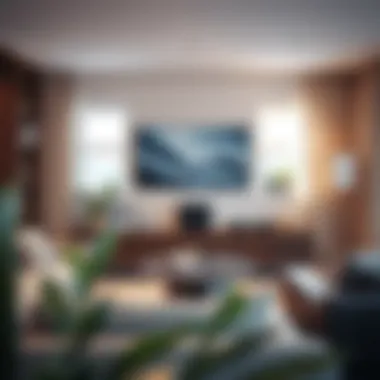
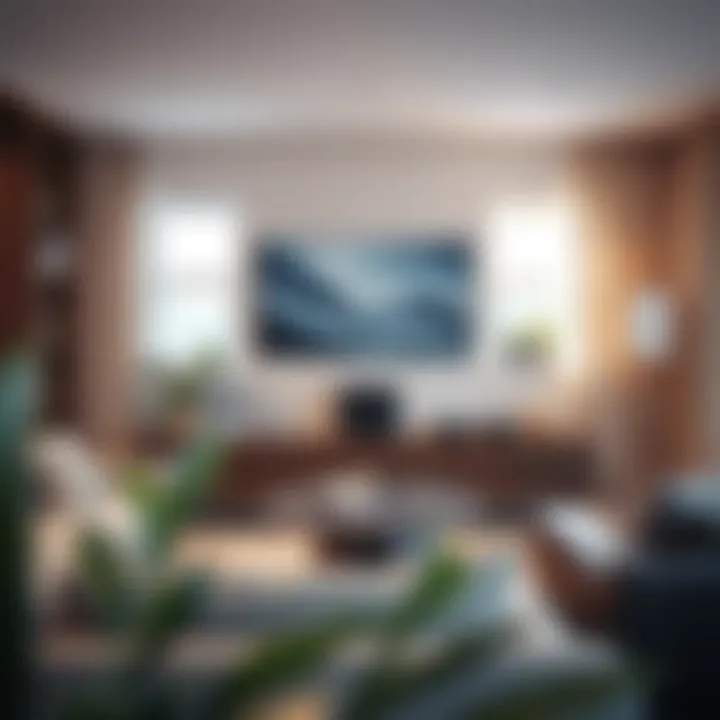
The journey of exploring Sonos shelves is truly about maximizing versatility, bringing together smart design and powerful technology—all tailored to suit the unique preferences of discerning homeowners and designers.
Design Principles of Sonos Shelves
The design principles of Sonos shelves significantly influence their functionality and aesthetic appeal. When it comes to modern smart home solutions, these shelves not only support audio gadgets but also enrich the overall decor of living spaces. It's essential to get the design aspects right, as they impact everything from material selection to how the shelves blend with existing furnishings. By focusing on design, homeowners and designers can maximize the use of Sonos shelves, ensuring that they serve not only as storage but also as an integral part of the home environment.
Materials and Aesthetics
Wood Options
Wood is often lauded for its warmth and natural beauty, which makes it a favored choice for Sonos shelves. The key characteristic of wood options lies in their versatility. Available in various types—from the robust oak to the elegant walnut—wood can suit diverse interior styles, be it rustic farmhouse or sleek modern. A unique feature of wood is its ability to absorb sound, providing a more immersive auditory experience. However, there are some disadvantages; for instance, wood can warp if placed in high-humidity areas. Thus, understanding the specific type of wood and its properties can greatly benefit the design choices you make.
Metal Finishes
Metal finishes bring a touch of sophistication and contemporary flair to Sonos shelves. The key appeal of metal is its durability and sleek look. Options like brushed stainless steel or powder-coated aluminum are popular for their minimalist vibe. A unique feature of metal finishes is their ability to seamlessly blend with industrial or modern decor while ensuring longevity and resistance to wear. On the downside, metal can be cold to the touch and may not provide the same warmth as wood. Therefore, it’s vital to consider the surrounding decor to maintain a homely atmosphere.
Glass Elements
Glass elements offer a sense of lightness and modernity to Sonos shelves. The key characteristic of glass shelves is their transparency, which can make a space feel more open and airy. Often used in conjunction with wood or metal, glass can enhance the visual appeal of a room. An advantage of using glass is that it can be easily cleaned and does not hold dust like some other materials do. However, one must be careful as glass can be fragile and needs appropriate support to prevent breakage. Thus, making informed choices about where and how to incorporate glass can truly elevate the design.
Functional Design Considerations
Weight Distribution
Proper weight distribution is crucial when installing Sonos shelves. The main focus here is on stability. Well-designed shelves will distribute weight evenly to prevent sagging or collapsing. This is particularly important when heavy devices are placed on the shelves, as improper distribution can lead to accidents or damage to the wall. Additionally, considering the material used in the shelf plays a role in how weight is supported. A unique aspect of this design consideration is the need for additional support brackets for heavier installations. Ultimately, emphasizing weight distribution enhances both safety and longevity.
Accessibility Features
Incorporating accessibility features into Sonos shelf design ensures that users of all abilities can engage with their audio systems. Key characteristics may include height-adjustable shelves or features that allow easy reach for people with mobility challenges. A unique aspect of these features is that they can significantly enhance the user experience. For instance, a shelf that’s too high can detract from the enjoyment of music or sound. However, one must balance accessibility and design aesthetics. It’s possible to create shelves that are both functional and visually appealing, making it important to thoughtfully integrate accessibility into your design strategy.
Installing Sonos Shelves
Installing Sonos shelves is not just a task—it's a gateway to transforming the auditory experience within your home. With the right setup, your living space can be more than just a place to sit; it can become an immersive environment filled with sound that envelops you. This section will guide you through the important aspects of installation, from the tools you’ll need to the strategies for ensuring optimal sound and aesthetic appeal.
Step-by-Step Installation Guide
Tools Required
When it comes to installing shelves, having the right tools can make all the difference. The essential tools typically include:
- Power Drill: A reliable power drill is indispensable for making precise holes. It offers speed and accuracy, saving you both time and effort.
- Stud Finder: This tool is a game changer. It helps you locate the wooden beams inside the wall, ensuring that your shelves are anchored securely, which is crucial for weight distribution.
- Level: A must-have for anyone looking to avoid a shelf that looks like it's been through an earthquake. Using a level ensures your shelf sits straight, contributing to a professional finish.
The characteristic of these tools is that they enable DIYers of all skill levels to achieve satisfactory results. They blend functionality with ease of use, making them a beneficial choice for novice and experienced installers alike. However, the downside of using these tools may arise if one lacks proper guidance on user safety, which can lead to unnecessary accidents.
Mounting Techniques
The way you mount your Sonos shelves plays a significant role in overall functionality. Two popular methods include bracket mounting and direct wall anchors.
- Bracket Mounting: This approach uses brackets to support the shelf, allowing for adjustments in height. It’s often favored because it permits a more custom arrangement based on individual needs.
- Direct Wall Anchors: This technique ensures that shelves are firmly secured to the wall. It’s a more permanent solution that is excellent for heavier speakers. However, removing it can leave marks that may require painting or repairs.
In choosing a mounting technique, consider your long-term goals. Bracket mounting offers versatility, while anchors provide sturdiness. Your choice affects both installation and the eventual aesthetics of the space.
Optimal Placement Strategies
Sound Projection Points
Identifying the optimal sound projection points can amplify your listening experience. Consider how sounds disperse in a room.
- Setup for Surround Sound: If you have multiple speakers, place them strategically around the room to create a sonic environment that feels all-encompassing. This not only enhances the audio experience but also creates an inviting atmosphere.
- Increased Speaker Positioning Flexibility: Understanding sound projection points grants you the freedom to alter your speaker placements to suit different gatherings or moods. The unique feature of focusing on sound projection is the ability to fine-tune the audio experience to your personal tastes.
Although advantageous, creating the perfect soundscape can be a trial-and-error process, often leading to a temporary clutter of wires and devices until you've nailed the correct setup.
Visual Line Alignment
The aesthetic of your room is just as important as sound quality. Visual line alignment helps maintain harmony within your space.
- Consistency in Design: Aligning your shelves with eye levels or other horizontal lines in the room can create a more cohesive look. This design choice speaks to the importance of having a polished finish in any layout.
- Guided Arrangement of Decorative Elements: Planning for visual line alignment allows you to prioritize how objects on the shelves blend together, adding to the overall theme of your living area.
However, overemphasizing line alignment can lead to rigidity in design, sometimes stifling creativity. The key is to strike a balance between formal alignment and casual personal expression.
By thoughtfully considering tools, mounting techniques, sound projection, and visual alignment, one can ensure a beautiful and functional Sonos shelf installation that not only serves a practical purpose but also enhances the overall living experience.
Maximizing Functionality with Sonos Shelves
In the realm of smart audio systems, Sonos shelves offer more than just a sleek setting for your speakers. They create a seamless environment where sound meets style. Maximizing their functionality is crucial for any homeowner or designer looking to enhance their auditory experience without compromising aesthetic appeal. This section dives into the pivotal features that transform these shelves into essential components of modern living.
Integration with Other Smart Devices
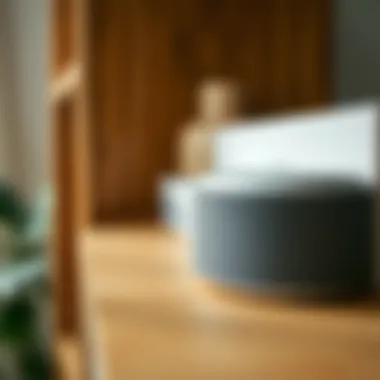
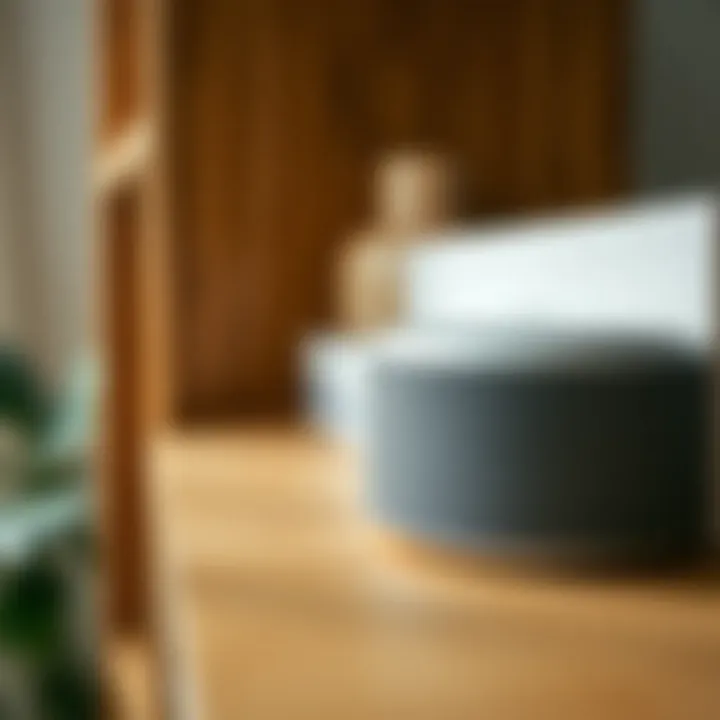
Voice Assistants
Voice assistants play a significant role in the Sonos ecosystem. Integrating devices like Alexa or Google Assistant with your Sonos shelves can simplify your daily routine. One of the key characteristics of voice assistants is their ability to control multiple smart devices through voice commands. This convenience is particularly beneficial for individuals who are looking for hands-free ways to manage their home technology.
A unique feature of voice assistants within this context lies in their functionality to adjust sound levels, switch playlists, or even turn off lights—all without lifting a finger. Such integration offers significant advantages, like enhancing the overall user experience, making it more enjoyable and atmospheric. However, keep in mind that while they provide ease of use, the reliance on internet connectivity can sometimes lead to frustrating hiccups when trouble arises.
Smart Lighting
Smart lighting complements the aesthetic and functional benefits of Sonos shelves beautifully. These systems allow you to synchronize lighting with your audio experience, creating an immersive atmosphere. The ability to modify brightness or color temperature is a key characteristic that stands out. This flexibility can greatly enhance listening sessions—whether it’s a relaxed evening with soft tunes or a lively gathering with upbeat music.
A unique feature of smart lighting is their compatibility with various mood-setting applications, which can elevate your space even further. This interplay between light and sound can either uplift or calm the ambiance, making it versatile for different occasions. One downside, however, is that setting up a coordinated system requires a bit more initial effort, which may not be ideal for everyone.
Layering Sound Experience
Multi-Room Audio Solutions
Multi-room audio solutions represent a transformative aspect of the Sonos experience. This setup allows for music to flow through various areas of the home, ensuring a harmonious audio environment. The ability to play the same track throughout different rooms or even select different songs for each space serves as its key characteristic, enhancing both practicality and enjoyment.
This approach is beneficial for social gatherings and relaxation alike, allowing sounds to waft through the home seamlessly. A noteworthy feature is the grouping capability that gives you flexibility in managing how sound is distributed. However, it can have limitations—such as requiring a reliable wireless connection and sometimes needing additional setup that could prove troublesome.
Synchronizing Speakers
Synchronizing speakers can elevate your sound experience to new heights. This feature takes the layering of sound one step further by ensuring that all speakers in a room work in unison. The key characteristic of synchronized audio lies in its ability to fill larger spaces with cohesive sound, avoiding the dreaded echo that might come from uncoordinated playback.
It's a popular choice for homeowners seeking a professional audio setup, as it balances sound across the room, making it feel immersive. However, the need for compatible devices and potential delays in response might pose certain challenges. While this offers a premium experience, the meticulous nature of setup may not appeal to everyone.
"Maximizing functionality with Sonos shelves transforms a simple space into a smart audio haven, redefining the listening experience."
Styling Your Sonos Shelf
Designing a visually appealing environment around your Sonos shelf is more than just aesthetics; it's about creating a space that resonates with your personality and enhances your listening experience. This segment emphasizes the significance of styling and how it can elevate both sound quality and the overall ambiance of your room. By paying attention to how you organize and display items around your Sonos shelf, you can blend functionality with style seamlessly.
Curating Decorative Elements
Art and Sculpture
Incorporating art and sculpture into your Sonos shelf layout adds an expressive dimension to your space. This kind of decorative element doesn’t just serve as a conversation starter; it can also reflect your taste and bring a personal touch to the room. A key characteristic of art is its ability to evoke emotions, which can enhance the auditory experience when combined with your Sonos setup.
For instance, placing a bold abstract sculpture next to a Sonos speaker might not only appeal to the eye but can also create an engaging focal point in the room. One unique feature of sculptures is their three-dimensional presence, which can draw attention and give depth to your design. However, it’s crucial to consider scale since oversized pieces might overshadow the speaker but can create a stunning contrast when balanced correctly.
Books and Accessories
Books and accessories are timeless options for styling a Sonos shelf. They not only add personality but also provide function. A tasteful stack of well-chosen books might signify your interests and passions, making your space feel more inviting. Moreover, they can serve as minimalist décor while still fulfilling an intellectual aesthetic.
The unique feature about books is that they can easily be swapped out, allowing you to refresh your shelf's appearance throughout the seasons, making them a flexible choice. One disadvantage could be the clutter they might add if not organized properly, potentially distracting from the sound experience. So, it’s wise to consider using decorative bookends or displayed in a neat, arranged manner.
Achieving Visual Harmony
Color Coordination
Color coordination plays a pivotal role in designing an appealing aesthetic around your Sonos shelf. Harmonizing colors of your decorative elements with the overall color scheme of your room can create a soothing environment that feels cohesive. A significant characteristic of effective color coordination is its ability to tie different components together, making sure they complement rather than clash.
This makes the space feel intentional. A beneficial feature of color coordination is that it can enhance the perception of your audio setup, meaning your sound environment can feel as good as it looks. On the downside, overthinkin' color schemes can leave you paralyzed in decision-making, leading to a potentially less personalized outcome.
Balancing Heights and Textures
Balancing heights and textures is essential in creating visual interest without overwhelming the senses. Different heights can bring life to your Sonos shelf, preventing a monotonous look. For example, juxtaposing a tall vase with an audio component can direct the eye smoothly across the shelf and help maintain focus on your Sonos speakers. The key characteristic of this approach is the dynamic balance it provides, making everything flow.
Adding various textures can enrich the tactile experience, promoting a cozy vibe. However, too many mixed textures could create chaos, distracting from the sound elements. Therefore, striving for an equilibrium is crucial and will yield more satisfying results when styling your Sonos shelf.
Visual harmony transforms a simple shelf into a statement piece, pairing sound and sight in a memorable way.
Maintaining Your Sonos Setup
Maintaining your Sonos setup is a crucial aspect of ensuring you get the most out of your audio experience. Regular upkeep not only extends the lifespan of your devices but also ensures that the sound quality remains top-notch. In a world where technology evolves faster than you can say "Sonos," keeping your equipment in good condition prevents frustrating audio mishaps and connectivity failures that could put a damper on your home entertainment.
Cleaning and Care Guidelines
Surface Materials
When it comes to surface materials, understanding their unique properties is vital for maintaining your Sonos shelves. Typically, these shelves are crafted from wood, metal, or even glass. Each material brings something special to the table. Wood, for instance, exudes warmth and can seamlessly blend with various décor styles, while metal adds a modern edge.
One of the key characteristics of wood is its tendency to absorb sound, which can be both a benefit and a drawback. On the plus side, wooden shelves can help in diffusing sound, leading to a more balanced audio experience. However, they can also easily accumulate dust and require more frequent cleaning. Regularly dusting these surfaces with a soft cloth helps keep them looking pristine while maintaining sound quality.
Metal finishes, on the other hand, are often resistant to dust and can be wiped clean with minimal effort. They are a popular choice among homeowners who value aesthetics as much as functionality. However, they can sometimes create audio reflections, which might be undesirable, depending on the room’s layout.
In terms of glass elements, these can be striking but require careful handling. Fingerprints, streaks, and scratches can undermine their appearance. Thus, using a suitable glass-cleaning solution can contribute to their longevity and visual appeal. Overall, understanding these intricacies helps you choose appropriate cleaning methods for your specific Sonos shelf materials.


Tech Maintenance
Tech maintenance is another cornerstone of ensuring your Sonos setup remains functional. Keeping your devices updated with the latest firmware can significantly enhance performance and security. This includes not just the speaker units but also any associated devices that integrate with your Sonos ecosystem. Regular software updates often come with improvements that can stabilize connectivity issues or improve sound quality.
One unique feature of Sonos products is their seamless integration with various operating systems. This allows users to control their audio experience through multiple devices, from smartphones to tablets. However, managing these connections requires oversight. Regular rebooting of devices can often resolve temporary glitches, giving you a reliable experience.
On the downside, tech maintenance may become cumbersome for users unfamiliar with the setups. Sometimes, automated updates may lead to unexpected changes in functionality. Thus, keeping a close eye on this aspect ensures that your setup stays true to your original preferences and specifications. Routine maintenance not only prevents potential frustrations but also maintains the overall quality of your setup.
Troubleshooting Common Issues
Audio Disturbances
Audio disturbances can be one of the more frustrating challenges you might encounter with your Sonos shelves. These can manifest as unexpected background noise, uneven sound distribution, or crackling speakers. Identifying the root cause often involves examining various factors, such as room acoustics or speaker placement. If your speakers aren’t positioned ideally, you might struggle with sound clarity.
Moreover, environmental factors like furniture placement can create disruptions as well, causing vibrations that impact sound quality. A beneficial strategy is to relocate your speakers and test various placements to discover the sweet spot for your audio experience.
Connectivity Problems
Connectivity problems are another common hurdle when maintaining your Sonos setup. These issues often arise from Wi-Fi instability, outdated firmware, or interference from other devices. One of the key characteristics of Sonos products is their reliance on seamless network connections, so ensuring a strong home network plays a pivotal role in your setup’s performance.
Investing in a good wireless router or a mesh network could dramatically reduce connectivity issues. Moreover, regularly checking for firmware updates ensures your devices are equipped with the latest enhancements. Remember to disconnect and reconnect devices as needed, a simple move that often resolves lingering connectivity woes.
In summary, maintaining your Sonos setup requires regular attention to both physical and technical aspects. By understanding the materials that compose your shelves, keeping up with tech updates, and proactively addressing common issues like audio disturbances and connectivity problems, you ensure that your audio experience remains as enriching as you envision.
Investing time in maintenance now can save you from headaches later. The more care you give to your setup, the more rewarding your listening experience will be.
Future Trends in Smart Shelving
The evolution of smart shelving is nothing short of captivating as technology interweaves with furniture design. With the rise in smart home integration, the significance of Sonos shelves in creating efficient living spaces cannot be overlooked. These shelves do more than just hold speakers; they represent a shift towards adaptability and intelligence in our layouts.
Emerging Technologies
AI Integration
AI integration in shelves is a game changer. Imagine a scenario where your shelf not only displays your audio equipment but also interacts with all smart devices in your home. This aspect allows for seamless automation, where voice commands can change your music, adjust lighting, or even switch off your devices altogether. The hallmark of this technology is its learning capability; it adapts to your habits over time and fine-tunes itself to meet your needs. However, while this integration offers convenience, one must consider privacy implications.
A unique feature of AI integration is its ability to diagnose issues with connectivity. In an ideal setup, if a speaker is malfunctioning, your shelf could notify you before you realize anything is amiss. The trade-off, however, is the need for a reliable internet connection which might inhibit performance if not well-managed.
Adaptive Design Features
Adaptive design features take versatility to a new level. These shelves can transform their shape or dimensions based on user interaction or environmental changes. For instance, a shelf can extend or retract based on room occupancy or even the time of day, creating a responsive space that enhances user experience. One of the key characteristics of adaptive design is its customization, which appeals to homeowners looking for unique solutions that cater specifically to their space.
While adaptive designs are certainly favorable, they can come with complexity in installation and set-up. Also, their cost may be higher than standard shelving solutions, which could deter some users.
Sustainability in Furniture Design
In a world where environmental concerns are growing, sustainability in furniture design is becoming imperative. Smart shelving is no exception, and eco-conscious homeowners are more likely to research their options thoughtfully. Incorporating sustainability not only enhances a home’s decor but also aligns with a wider movement towards responsible consumption.
Eco-Friendly Materials
The shift towards eco-friendly materials is notable. These materials, often sourced from recycled or renewable resources, lessen the overall carbon footprint of producing new furniture. Utilization of bamboo, reclaimed wood, or recycled metals are prime examples that add both character and sustainability to Sonos shelves. A key characteristic is their durability; while they are environmentally friendly, they also withstand the test of time, which benefits users in the long run.
One unique feature these materials bring is their aesthetic flexibility, complementing any home style a person might prefer. However, some users may worry about the higher upfront costs associated with eco-friendly options.
Energy Efficiency
Energy efficiency in the context of smart shelving emphasizes the need for devices that minimize energy consumption. Innovative technologies embedded in Sonos shelves can automatically sense when no one is around and switch off connected speakers or lights, leading to lower energy bills.
The hallmark of energy-efficient designs is smart technology, promoting a balance between convenience and responsibility. Therefore, households adopting this trend can enjoy superior sound while embracing sustainable practices. A downside can be that integration of energy efficiency features sometimes complicates the technology, which may pose a challenge during set-up for some users.
In summary, as smart shelving evolves, embracing these futuristic trends not only enhances home functionality but also paves the way for a more sustainable and user-friendly environment.
Epilogue and Final Thoughts
The exploration of Sonos shelves reveals not only their essential role in modern home design but also their capacity to elevate auditory experiences in unique ways. As smart home technology continues to evolve, understanding how to effectively evaluate and integrate these pieces into our living spaces becomes increasingly important.
Evaluating Your Needs
When contemplating the incorporation of Sonos shelves into your home, it’s prudent to assess your unique requirements. Start by asking yourself a few critical questions:
- What is my primary purpose for the shelves? Are you looking to simply display audio equipment, or do you want to create a focal point that enhances the room's aesthetic?
- How much space do I have? Understanding the dimensions of your area can guide your decisions, ensuring both functionality and style.
- What is my budget? It’s key to establish a financial framework before diving headfirst into selection. Keep in mind, investing in good quality often trumps quantity.
Additionally, consider your existing decor and what styles resonate with you. Create a vision board, perhaps drawing inspiration from sites like Pinterest or Houzz, to help visualize how the Sonos shelves will fit in with the surrounding elements.
Balancing Function and Aesthetics
Finding harmony between functionality and visual appeal is a cornerstone of successful interior design. Sonos shelves offer a unique opportunity to blend these two aspects. Here are a few considerations that can assist in this balancing act:
- Material Choices: Opt for materials that not only complement your existing décor but also offer durability. Wooden shelves might provide warmth, while metal could add a modern edge.
- Placement and Arrangement: Strategic placement can enhance both sound quality and design. Ensure that your shelves are in optimal locations that provide the best acoustic clarity, while also being visually accessible.
- Color Schemes: Aligning the color of your shelves with the rest of the room can help establish a cohesive look. Experimenting with different shades can yield surprising results in visual impact.
- Texture Mixing: Introducing a variety of textures can add depth and interest. Combine smooth surfaces with more tactile materials for an intriguing layout.
"A well-placed shelf does more than hold your things; it shapes your space and elevates your experience."
For further reading and inspiration, explore resources like Wikipedia on Smart Shelving or visit Houzz for design ideas for detailed guides and a plethora of images.

